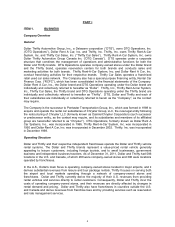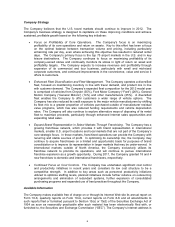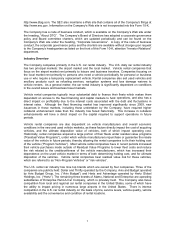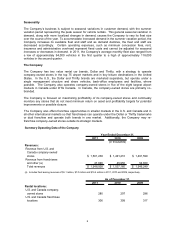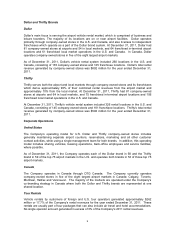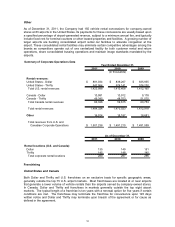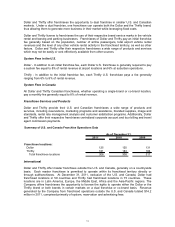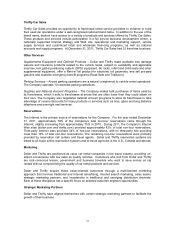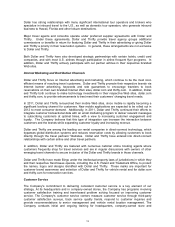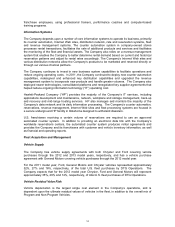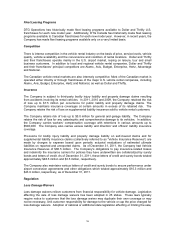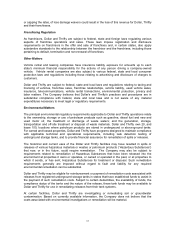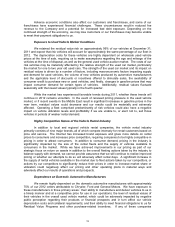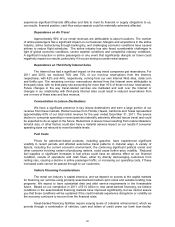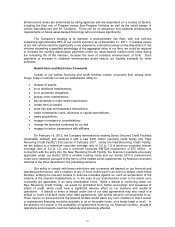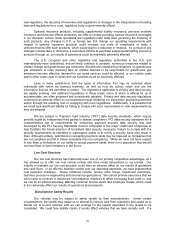Thrifty Car Rental 2011 Annual Report Download - page 17
Download and view the complete annual report
Please find page 17 of the 2011 Thrifty Car Rental annual report below. You can navigate through the pages in the report by either clicking on the pages listed below, or by using the keyword search tool below to find specific information within the annual report.DTG Operations primarily purchases Non-Program Vehicles, for which it bears the full risk and
potential benefits of changes in residual values because the vehicles are not covered by a
manufacturer’s Residual Value Program. Non-Program Vehicles typically have lower acquisition
costs and lower depreciation rates than comparable Program Vehicles, and also allow the Company
to reduce its risk related to the creditworthiness of the vehicle manufacturers. The manufacturer
does not set any terms or conditions on the resale of Non-Program Vehicles other than requiring
minimum holding periods. At December 31, 2011, approximately 96% of all vehicles operated by
DTG Operations were Non-Program Vehicles. In 2011, 2010 and 2009, the Company recorded
gains on sales of Non-Program Vehicles of $46.9 million, $63.1 million and $35.1 million,
respectively. These gains represented an average gain per Non-Program Vehicle sold of $1,190,
$1,105 and $700 in 2011, 2010 and 2009, respectively.
Under Residual Value Programs, the manufacturer either guarantees the aggregate depreciated
value upon resale of covered vehicles of a given model year, or agrees to repurchase vehicles at
specified prices during established repurchase periods. These programs provide the Company with
a guaranteed depreciation rate per vehicle during the holding period, while minimizing the
Company’s residual value risk.
As the level of Non-Program Vehicles in the fleet has increased, the Company has assumed
additional risk related to fluctuations in the residual value of the vehicle, and has increased its
reliance on the used vehicle markets. The residual value market fluctuates seasonally with the
lowest values typically in the fourth quarter. Residual values depend on levels of supply and
demand for both new and used vehicles, seasonality in the residual value market, fuel prices and
consumer perceptions of manufacturer quality, and directly affect vehicle depreciation rates. The
level of the Company’s future investment in Program Vehicles will depend on the availability and
attractiveness of Residual Value Programs, although the Company does not anticipate any material
change in its fleet mix for the foreseeable future.
Vehicle Remarketing
DTG Operations typically holds Non-Program Vehicles in rental service for approximately 18 to 22
months. DTG Operations remarketed approximately 60% of its Non-Program Vehicles through
auctions and approximately 40% directly to used car dealers, wholesalers and its franchisees during
the year ended December 31, 2011.
DTG Operations typically holds Program Vehicles in rental service for approximately six to eight
months. Generally, Program Vehicles must be removed from service before they reach 30,000 miles
to avoid excess mileage penalties under manufacturers’ Residual Value Programs. DTG Operations
must bear the risk on the resale of Program Vehicles that cannot be returned.
Fleet Management
The Company utilizes fleet optimization software (the “Pros Fleet Management Software”) from
PROS Holdings, Inc., a leading provider of pricing and revenue optimization software. The Pros
Fleet Management Software allows the Company to improve fleet planning and efficiencies in its
vehicle acquisition and remarketing efforts.
Vehicle Financing
The Company requires a substantial amount of debt to finance the purchase of vehicles used in its
rental fleets. The Company utilizes asset-backed medium-term notes and variable funding note
programs to finance its vehicles. Under asset-backed medium-term notes, the Company is required
to provide collateral at different levels depending on whether vehicle manufacturers maintain
investment grade or non-investment grade credit ratings, and whether inventory is comprised of
Program Vehicles or Non-Program Vehicles. Under variable funding note programs, the Company is
required to provide collateral at a fixed level. See Part II, Item 8 - Note 8 of Notes to Consolidated
Financial Statements.
15


